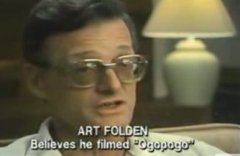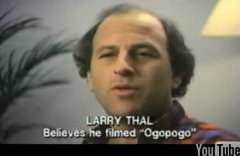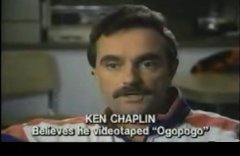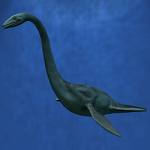Video by Dan Basaraba click here: http://www.youtube.com/watch?v=2qmGs0clU8c
History of video and film of Ogopogo
Original Source: mysterycasebook.com/lakemonster.html

In 1968, the very first video film of Ogopogo was taken by sawmill worker Art Folden. He was driving along Okanagan, and glancing at the lake, he noticed something strange in the water. What Folden saw was near the shore, and he pointed out his sighting to his wife. He stopped his car, and got out to take film of the disturbance.
The creature would dive under the water and then reappear. Upon each reappearance, Folden shot his film. The video shows the creature moving from shore into the deeper waters of the lake, finally diving under for good.
By estimating the height of the trees on shore, it can calculated the the length of the animal that Foley filmed was about 40 feet, approximately the same size as the monster of Loch Ness. The film has been enhanced by investigators, and clearly shows a "dark object" moving through the waters. The film has become known as one of the classics of lake monster lore.

Twelve years after the Art Folden Film, in 1981, another riveting film of the Ogopogo monster would be taken. Larry Thal, who was with a group of tourists who thought they saw a large creature in the lake, had his motion picture camera with him.
Thal, who had been filming his kids, turned his camera toward the waters of the lake.
Thal stated that what he saw was a "strange sight." Researchers who studied slow motion enhancements of the film proclaim that the method of movement of the monster can be seen, and its speed also.
Waves are created as the creature moves along, and at one brief point, part of the body rises from the surface of the water.
Ogopogo researcher and author Arlene Gaal claims that the Thal film is very closely related to the Folden film. Both seem to show a large creature 40-60 foot in length.

On July 18, 1989, Clem Chaplin spotted Ogopogo swimming among a group of logs not far from the shores of Okanagan. He told his one Ken about the sighting. Ken took his video camera and waited for a chance to film the legendary monster. His patience was rewarded with an extraordinary film of Ogopogo. The creature appeared to be hairless, greenish in color, and about 15 feet long.
He was about 75-100 feet away from the monster as he rolled the film. In one startling moment, the monster can be seen thrashing the water with its snake-like body as it raised its head above the water.
Some skeptics have proposed that the "flapping" motion can be attributed to a beaver, but proponents of the film have claimed that beavers, unlike the creature in the Chaplin film, lowers its head when flapping its body in the water. Ken Chaplin also pointed out that the creature he saw was some 15 feet in length, whereas the largest known beavers only measured 4 1/2 feet in length.
A few days later, accompanied by his father, and his daughter Cory, returned to the location of the previous footage, and amazingly they again spotted Ogopogo, and took additional footage of the creature.
The film caused great excitement and new hope for lake monster hunters. Could there be a real creature living in Lake Okanagan of a yet to be determined zoological species? A good look at the Ken Chaplin film may just substantiate this claim.
In addition to these men mentioned above, Eugene Boiselle (1982), Dr Rod Simmons (1989), Paul DeMara (1993), John Kirk (1987,1989) and Dan Basaraba (2001,2005) have all obtained film or video footage of an unusual creature moving through the waters. |
